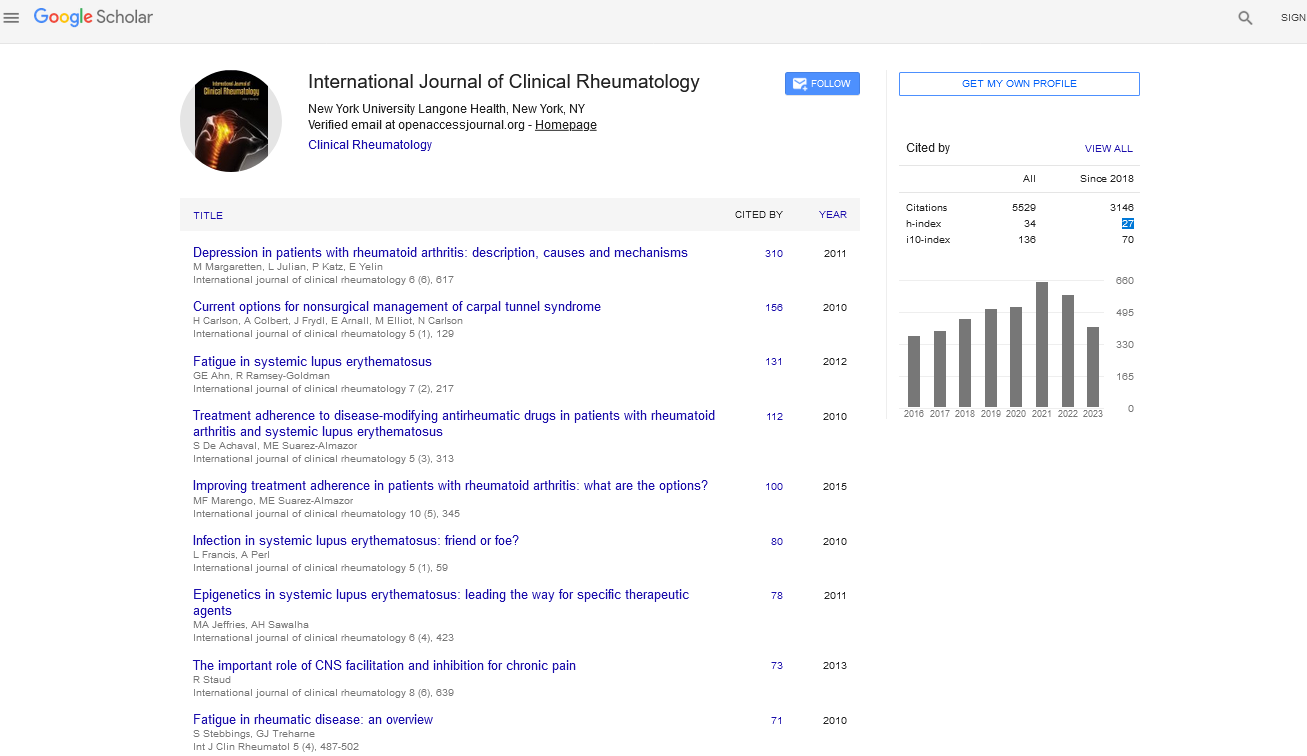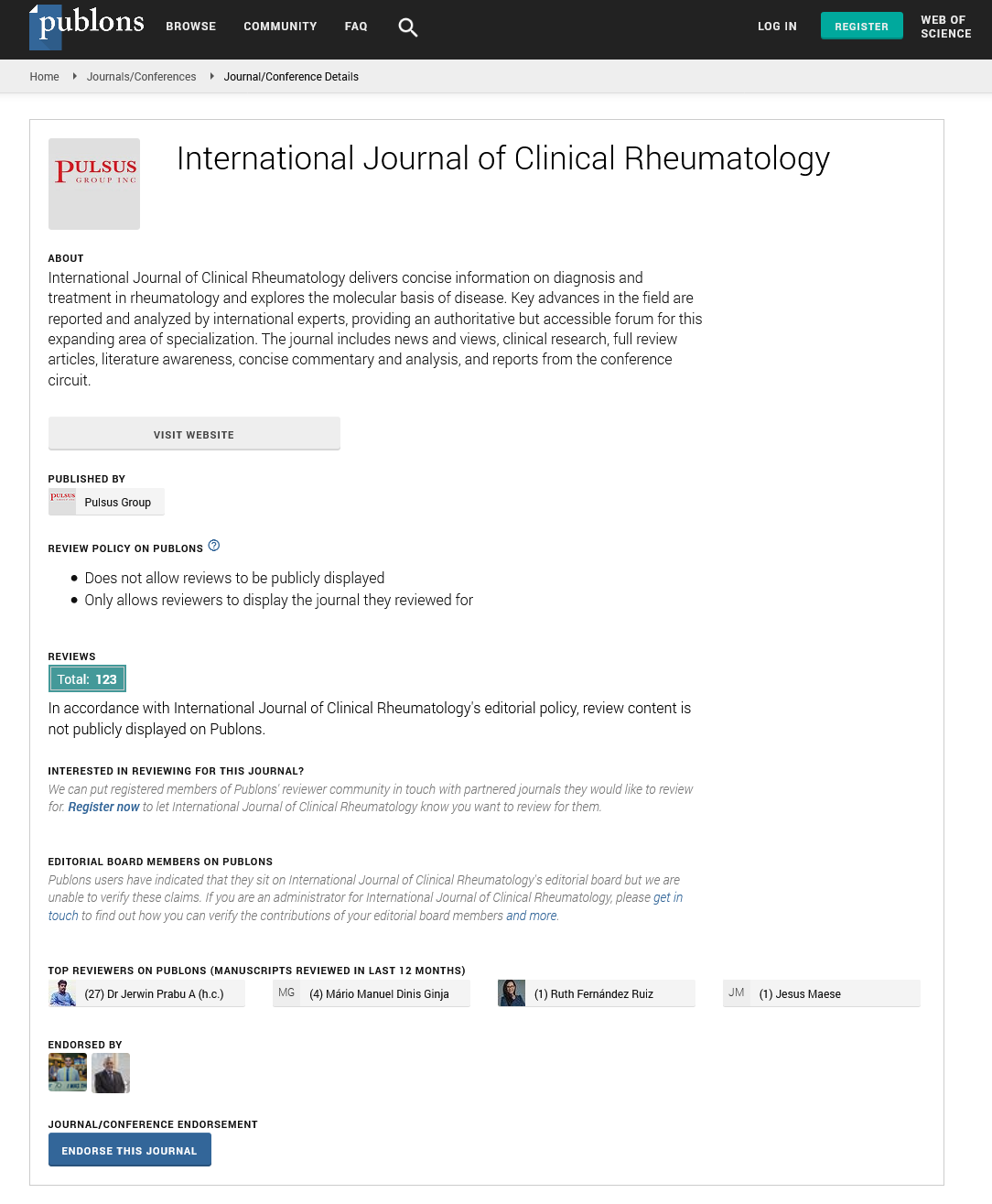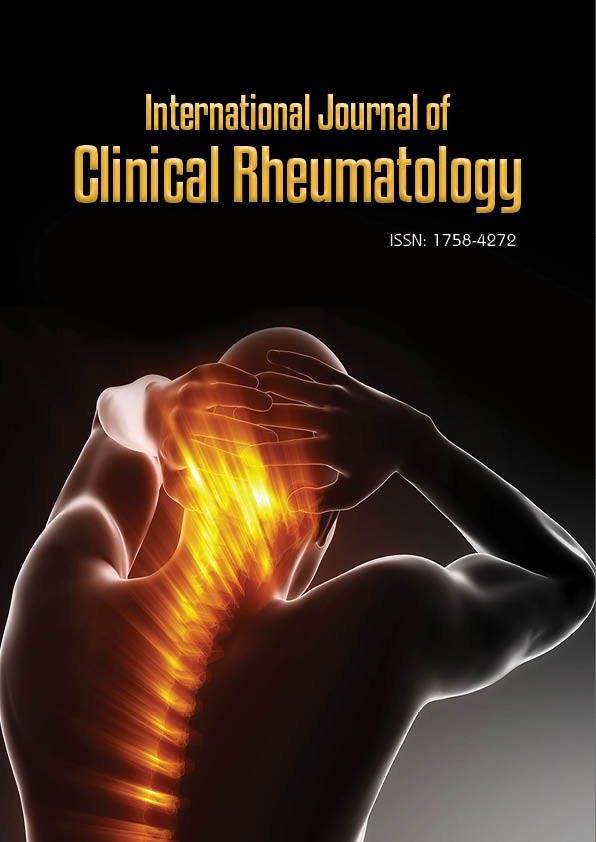Perspective - International Journal of Clinical Rheumatology (2024) Volume 19, Issue 11
Exploring the Genetic Underpinnings of Ankylosing Spondylitis: A Comprehensive Review of Genome-Wide Association Studies
Alice Johnson*
Department of Rheumatology, All India Institute of Medical Sciences (AIIMS), New Delhi, India
- *Corresponding Author:
- Alice Johnson
Department of Rheumatology, All India Institute of Medical Sciences (AIIMS), New Delhi, India
E-mail: alice.johnson1234@mail.com
Received: 02-Nov-2024, Manuscript No. fmijcr-25-157438; Editor assigned: 04- Nov-2024, Pre-QC No. fmijcr-25-157438 (PQ); Reviewed: 18-Nov-2024, QC No. fmijcr-25-157438; Revised: 23-Nov- 2024, Manuscript No. fmijcr-25-157438 (R); Published: 30-Nov-2024, DOI: 10.37532/1758-4272.2024.19(11).340-343
Abstract
Ankylosing spondylitis (AS) is a chronic inflammatory disease that primarily affects the axial skeleton, with a strong genetic component. This review examines the findings from recent genome-wide association studies (GWAS) to identify genetic variants associated with AS. The analysis highlights key loci, such as HLA-B27 and non-HLA genes, which are implicated in disease susceptibility. Furthermore, the review explores the potential mechanisms by which these genetic factors contribute to the pathogenesis of AS, providing insights into new therapeutic targets. The growing understanding of AS genetics may lead to more personalized treatment strategies in the future.
Keywords
Ankylosing spondylitis● Genetics● Genome-wide association studies● HLA-B27● Non-HLA genes● Inflammatory diseases● Pathogenesis
Introduction
Ankylosing spondylitis (AS) is a chronic inflammatory disease primarily affecting the axial skeleton, leading to pain, stiffness, and potential fusion of the spine. It is a subset of spondyloarthropathies and is closely linked with the human leukocyte antigen B27 (HLA-B27), a genetic marker that plays a significant role in its pathogenesis. However, the complete genetic underpinnings of AS have yet to be fully understood, with numerous non-HLA genetic loci contributing to disease susceptibility. Over the last two decades, advances in genomics and technology have facilitated large-scale Genome-Wide Association Studies (GWAS), providing valuable insights into the genetic risk factors associated with AS. These studies have identified a range of genes beyond HLA-B27 that may contribute to the disease's onset and progression [1]. This review aims to explore the key findings of GWAS in ankylosing spondylitis, shedding light on the molecular mechanisms involved, their implications for diagnosis, treatment, and potential for personalized medicine in AS management.
Discussion
Genetic Architecture of Ankylosing Spondylitis
Ankylosing spondylitis is strongly associated with genetic predisposition, particularly the presence of HLA-B27, but the complete genetic landscape of the disease is more complex. GWAS have significantly advanced the understanding of AS by identifying many other loci that contribute to the disease, although they do not entirely explain the disease's heritability. Several studies have highlighted the presence of common variants within key immune-related genes. These discoveries have provided insight into the immune system's role in AS pathogenesis, as well as the potential for novel therapeutic targets. HLA-B27 remains the strongest genetic risk factor for AS, with individuals carrying this allele having a much higher risk of developing the disease. It is estimated that 90-95% of patients with AS are HLA-B27 positive, though the presence of this allele alone is not sufficient to cause the disease [2]. The genetic contribution of HLA-B27 is thought to involve both the immune response and the ability to present antigens to T cells, thus influencing the development of autoimmune responses. However, the exact mechanism remains under investigation, with hypotheses suggesting that misfolding of the HLA-B27 protein could trigger abnormal immune responses, leading to inflammation in the joints. Beyond HLA-B27, GWAS have identified more than 30 additional genetic loci associated with AS. Many of these loci are involved in the regulation of immune pathways and inflammatory responses. Notable findings include associations with genes such as IL-23R, ERAP1, and TNFSF15, which play roles in the immune system's inflammatory processes [3].
IL-23R (Interleukin-23 Receptor)
IL-23R is one of the most robustly associated genes identified in AS through GWAS. The IL-23/IL-17 axis is central to the pathogenesis of AS, as it is involved in the differentiation of T-helper cells, particularly Th17 cells, which produce pro-inflammatory cytokines like IL-17. Variants in the IL-23R gene lead to an altered immune response, which can contribute to the chronic inflammation characteristic of AS. This discovery has opened the door to potential therapeutic strategies targeting the IL-23/IL-17 pathway.
ERAP1 (Endoplasmic Reticulum Aminopeptidase 1)
The gene ERAP1 has also been implicated in AS risk through its role in peptide trimming, which affects antigen presentation to the immune system. ERAP1 influences the binding of peptides to HLA-B27, and genetic variations in ERAP1 are believed to modulate the risk of AS by affecting the peptide repertoire displayed by HLA molecules. Studies have suggested that specific ERAP1 variants alter the immune response, potentially increasing susceptibility to AS in individuals carrying HLA-B27 [4].
TNFSF15 (Tumor Necrosis Factor Superfamily Member 15)
TNFSF15 is another gene linked to AS susceptibility, particularly in populations of European descent. It encodes a cytokine involved in immune regulation and inflammation, with evidence suggesting its role in modulating inflammatory responses in AS. Variants of TNFSF15 may influence the balance between pro-inflammatory and anti-inflammatory cytokines, thereby contributing to the chronic inflammation and bone damage observed in AS.
Immune Pathways and Mechanisms
One of the primary contributions of GWAS to understanding AS is the identification of immune-related pathways that are crucial to disease development. The findings point to an underlying dysfunction in the immune system, particularly within the innate and adaptive immune responses. The dysregulated activation of T cells, particularly Th17 cells, has been widely implicated in AS. These cells produce inflammatory cytokines, such as IL-17A, that drive the pathological inflammation seen in the joints of individuals with AS. GWAS results consistently highlight genes involved in the IL-23/IL-17 signaling axis, solidifying the importance of this pathway in AS pathogenesis. In addition to the immune system, studies have indicated the involvement of other systems, including the bone remodeling and inflammatory pathways. For example, genes like TGF-beta1 and others involved in the Wnt signaling pathway have been associated with the disease, highlighting the role of abnormal bone growth and remodeling in AS progression. The formation of new bone (syndesmophytes) in the spine, a hallmark feature of AS, is a result of inflammatory processes affecting bone turnover [5].
Clinical Implications and Personalized Medicine
The discoveries made through GWAS have profound implications for clinical practice, particularly in the realm of personalized medicine. Identifying genetic risk factors for AS allows for better understanding of the disease's etiology, helping clinicians predict which individuals are at higher risk for developing AS based on their genetic profile. This could lead to earlier interventions and better management strategies. Furthermore, GWAS findings have the potential to guide therapeutic approaches. Many of the genes identified are involved in immune regulation, making them potential targets for new biologic therapies. For example, inhibitors of IL-23 or IL-17, such as secukinumab and ustekinumab, are already being used to treat AS and are based on the understanding of immune pathways discovered through genetic studies. The identification of additional genetic variants associated with immune dysregulation could lead to the development of more targeted therapies, improving outcomes for patients with AS [6].
Conclusion
Ankylosing spondylitis is a complex disease with a multifactorial genetic basis. While the HLA-B27 allele remains the strongest risk factor, recent advancements in GWAS have revealed a broad spectrum of additional genetic loci that contribute to AS susceptibility. These findings underscore the role of immune system dysregulation, particularly in the activation of Th17 cells and the IL-23/IL-17 pathway, in the pathogenesis of AS. Furthermore, the identification of genetic risk factors holds significant potential for advancing personalized medicine in AS, with the possibility of earlier detection, more targeted therapies, and improved patient outcomes. However, further research is needed to fully elucidate the genetic and molecular mechanisms driving AS, as well as to refine therapeutic strategies aimed at modulating the immune response and halting disease progression. With continued advances in genomic technologies, the future of AS research holds promise for a deeper understanding of the disease and the development of more effective treatments.
References
- Hurria A (2007) Clinical trials in older adults with cancer: past and future. Oncology 21: 351–358.
- Carol A, Selby TR, Siu LL (2005) Systematic review of barriers to the recruitment of older patients with cancer onto clinical trials. J Clin Oncol 23: 3112–3124.
- Muss H, Biganzoli L, Sargent D, Aapro M (2007) Adjuvant therapy in the elderly: making the right decision. J Clin Oncol 25: 1870–1875.
- Extermann M, Aparo M (2000) Assessment of older cancer patients. Hematol Oncol Clin North Am 14: 63–77.
- Extermann M (2003) Studies of comprehensive geriatric assessment in patients with cancer.Cancer Control10: 463–468.
- Guralink JM (1996) Assessing the impact of comorbidity in the older population.Ann Epidemiol 6: 376–380.
Indexed at, Google Scholar, Crossref
Indexed at, Google Scholar, Crossref
Indexed at, Google Scholar, Crossref
Indexed at, Google Scholar, Crossref


